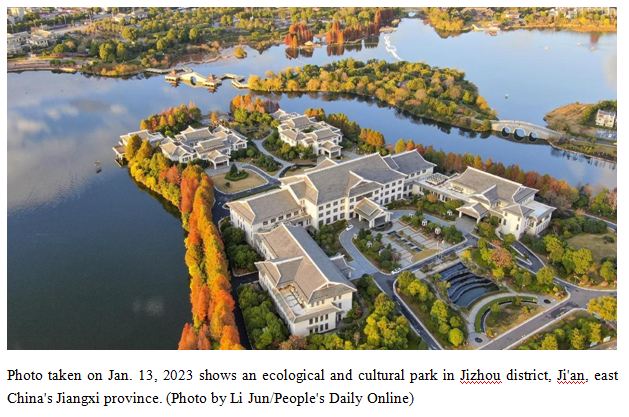By Liu Fawei
Green has become a defining feature of China in the new era. Green development and low-carbon transition remained focuses in the government work reports recently delivered by Chinese provinces during the local “two sessions,” the annual meetings of provincial-level lawmakers and political advisors.
“Green development,””carbon reduction,” and “pollution reduction” were buzzwords during the meetings.
According to statistics from China’s Ministry of Ecology and Environment, in 2022, the emissions of major pollutants in China kept a continuous decline, and the country has hit the targets in improving ecological and environmental quality. This marked hard-won achievements in the country’s ecological and environmental protection.
Beijing, recording a higher number of days with a blue sky, has delivered satisfying performance in green development.
Over the past five years, the capital of China has made earnest efforts to make its sky bluer. The average annual concentration of fine particles in the air dropped to 30 micrograms per cubic meter, a 48.3 percent decline from 2017, which is hailed as “Beijing miracle” by the United Nations Environment Program.
Hebei, a neighboring province of Beijing, is seeing a future full of vitality thanks to its afforestation efforts. So far, the province’s forest coverage has been raised to 35.6 percent, and the Saihanba mechanized forest farm situated in the northernmost part of the province has won the Land for Life Award of the United Nations.
In central China’s Hubei province, chemical engineering clusters along the Yangtze River are no longer a headache today. The province has shut down, overhauled, relocated, and transformed 452 chemical enterprises along the river and inspected 12,480 sewage draining outlets into the river, 9,067 of which have been renovated.
In east China’s Anhui province, the proportion of surface water sections with good water quality under national assessment has improved from 71.7 percent to 86.1 percent. Phased results have been achieved thanks to a 10-year fishing ban on the Yangtze River. Today, the ecological environment on the river is getting better and better.
In recent years, China has firmly upheld the belief that lucid waters and lush mountains are invaluable assets. It has prioritized eco-environmental conservation and green development, promoted the comprehensive green transformation of economic and social development, and achieved modernization based on harmony between humanity and nature. Wonders have been accomplished in eco-environmental protection and green development.
At present, the entire country is passionate about advancing the green transition. Many provinces have vowed, in government work reports, to promote green and low-carbon development, strive for the green transition of traditional industries and focus on green sectors.
Beijing plans to promote green and low-carbon development of industrial parks, strengthen low-carbon pilot programs, and accelerate the application of advanced low-carbon technologies such as renewable energy and integrated buildings.
Southwest China’s Yunnan province said it would vigorously promote the circular economy in the next five years, build centers for the comprehensive use of massive solid waste and industrial resources and set up a batch of zero-carbon demonstration parks.
Inner Mongolia autonomous region in north China encouraged industrial enterprises to use green electricity, techniques and materials, and to build more low-carbon and zero-carbon plants.
The country’s vigorous efforts to develop green industries are generating new opportunities for the ecological and environmental protection industries. According to the estimation by China Association of Environmental Protection Industry (CAEPI), the Chinese environmental protection industry reported revenue of around 2.2 trillion yuan ($317.5 billion) last year, up 1.9 percent from 2021.
CAEPI president Guo Chengzhan told People’s Daily that thanks to the implementation of the fiscal, financial, and investment policies as well as other measures to stabilize growth and promote development deployed by the Central Economic Work Conference, the investment in the environmental protection industry will experience obvious growth this year from 2022.
Realizing the “dual carbon” goals, or peaking carbon dioxide emissions before 2030 and achieving carbon neutrality before 2060, is a complicated and systematic mission. To achieve these goals, many provincial-level regions in China are focusing on the green and low-carbon transition of the energy structure.
On the one hand, many provinces said they would work to improve the utilization of coal and other traditional energies. Hebei province vowed to accelerate energy restructuring, promote clean and efficient utilization of coal, and expand installed capacity of renewable energy by 10 million kW. Shanxi province also stressed improving the clean and efficient utilization of coal and finding a better balance between the use of coal and new energy.
On the other hand, provinces are also planning to promote the development of new energy power generation and other relevant industries.
South China’s Guangdong province proposed to accelerate the building of a new type of energy system, develop offshore power, pumped-storage hydroelectricity, and other new and clean energy, advance the progress of storage battery projects and vigorously develop new energy storage industries.
East China’s Zhejiang province vowed to be a pioneer in building a new type of energy system and construct coastal nuclear power, pumped-storage hydroelectricity, offshore wind power, and oil and gas storage bases.
Anhui province said it will launch a program that aims to double its installed capacity of wind power, promote the development of the whole industrial chain of the hydrogen energy sector, and improve the installed capacity of renewable energy by at least 4 million kW.












